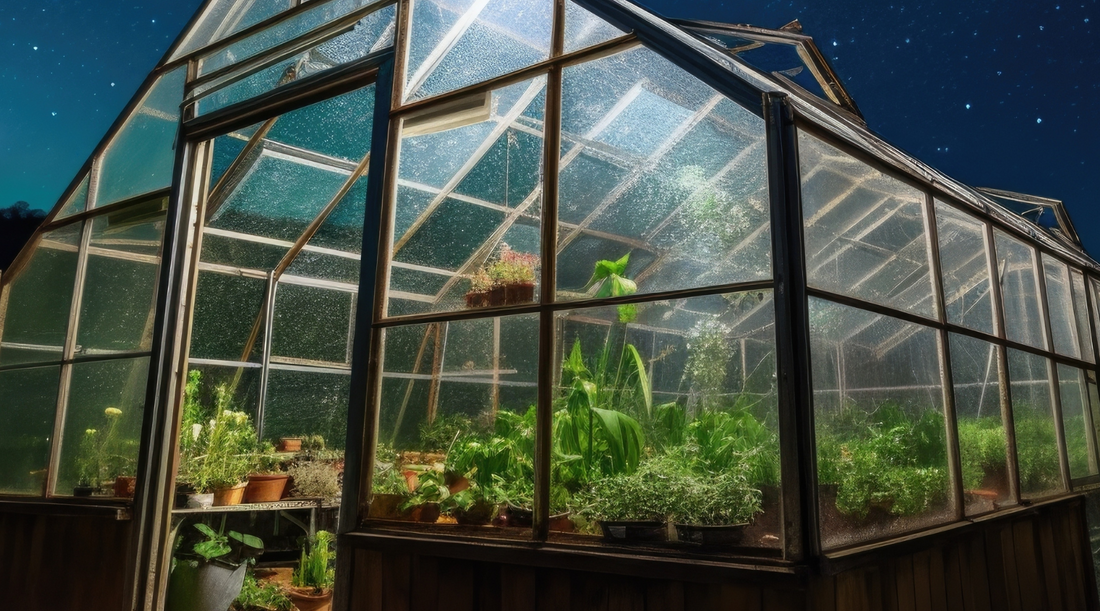
How to Choose Greenhouse Grow Lights
Growing healthy plants year-round is possible in modern gardening, where seasons merge and green thumbs rule. Greenhouse grow lights have revolutionized plant care you can grow organic vegetables or flowers. Whether you're a seasoned horticulturist or just starting, the appropriate grow lights may make or break your greenhouse.
This article guides you with greenhouse grow lights. Please join me on this informative journey to learn how to make your greenhouse a vibrant, colorful, growing oasis. Light the proper way and watch your greenhouse garden thrive like never before.
Importance of Grow Lights in Greenhouse
Grow lights greatly affect plant growth in greenhouses. Here are some reasons why greenhouse grow lights are essential:
Extended Growing Seasons:
Grow lights enable greenhouse gardeners to extend the growing season beyond the limitations of natural sunlight. This is especially important in regions with short daylight hours or during winter when sunlight is scarce. With the right spectrum and intensity, plants can continue to thrive and produce, ensuring a consistent supply of fresh produce year-round.
Light Spectrum Optimization:
Different types of plants have specific light spectrum requirements for optimal growth. Grow lights can be tailored to emit the exact spectrum of light plants need at various stages of their lifecycle, from seedling to flowering and fruiting. This customization enhances photosynthesis, chlorophyll production, and overall plant health.
Supplemental Lighting:
In areas where natural sunlight might be insufficient or inconsistent, grow lights act as supplemental lighting sources. This ensures that plants receive consistent and uniform light exposure, preventing leggy growth or uneven development.
Higher Yields and Faster Growth:
Grow lights provide a controlled environment where light intensity and duration can be finely tuned. This control often leads to accelerated growth rates and increased yields, as plants can photosynthesize more efficiently. Additionally, controlled lighting can trigger certain growth responses, such as flower induction, resulting in earlier and more abundant flowering.
Optimal Light Intensity:
In a greenhouse, light intensity can vary due to factors like shading from neighboring structures or uneven spacing of plants. Grow lights can be strategically positioned to deliver consistent light intensity to all plants, minimizing potential growth disparities.
Energy Efficiency:
Advanced grow light technologies like LED lights have significantly improved energy efficiency. Compared to traditional lighting systems, LEDs consume less energy while providing higher light output. This reduces operational costs and makes it more sustainable to maintain a well-lit greenhouse environment.
Research and Experimentation:
Grow lights allow researchers and growers to experiment by manipulating light conditions. This can lead to innovations in plant breeding, cultivation techniques, and understanding how plants respond to different light parameters.
Control over Photoperiod:
Some plants are photoperiod-sensitive, meaning their growth and flowering are influenced by the length of daylight hours. With grow lights, growers can artificially control the photoperiod, tricking plants into flowering outside their natural season.
Disease Prevention:
In environments with high humidity or excessive moisture, natural sunlight might not penetrate well, leading to increased chances of fungal diseases. Properly designed grow light systems can penetrate dense canopies, reducing the risk of such diseases by promoting better air circulation and drying.
Types of Grow Lights
High-Intensity Discharge Lights (HID Lights), including Metal Halide (MH) and High-Pressure Sodium (HPS) lights, have been traditional choices. MH lights emit blue light suitable for vegetative growth, while HPS lights produce red light for flowering.
LED Grow Lights (LED lights) are versatile and energy-efficient. They come in various spectrums, can be fine-tuned for different growth stages, and emit less heat. Although the upfront cost is higher, the efficiency and lifespan compensate over time.
Fluorescent Lights are cost-effective and work well for seedlings and young plants. They emit low heat and are available in different spectrum options.
Types of Greenhouse Grow Lights
There are many greenhouse grow lights with different features and benefits. Common greenhouse grow lights include:
1. LED Grow Lights:
Light Emitting Diode (LED) grow lights have gained significant popularity due to their energy efficiency, customizable light spectra, and long lifespan. LEDs can be tuned to provide specific wavelengths of light that cater to different plant growth stages. They emit less heat and are adjustable, making them suitable for a wide range of plants.
2. High-Intensity Discharge (HID) Lights:
- Metal Halide (MH) Lights: MH lights emit a blue spectrum of light that is ideal for promoting vegetative growth. They are often used during the early stages of plant development.
- High-Pressure Sodium (HPS) Lights: HPS lights emit a reddish-orange spectrum that is beneficial for flowering and fruiting stages. They are commonly used to enhance yield during the flowering phase.
Fluorescent Grow Lights:
T5 lights emit a balanced light spectrum and are often used for starting seedlings and growing young plants. They are energy-efficient and produce less heat, making them suitable for maintaining cooler temperatures in a greenhouse.
Ceramic Metal Halide (CMH) Lights:
CMH lights combine the benefits of both MH and HPS lights, providing a broad spectrum of light that is suitable for the entire plant life cycle. They offer a good balance between energy efficiency and light quality.
Induction Grow Lights:
Induction lights are known for their long lifespan and low maintenance requirements. They provide a wide spectrum of light and are relatively energy-efficient. However, they might not be as popular as other options due to their higher upfront cost.
Plasma Grow Lights:
Plasma lights are a relatively newer technology that offers a broad spectrum similar to natural sunlight. They are efficient and have a longer lifespan compared to traditional HID lights.
Laser Grow Lights:
Laser lights are a cutting-edge technology that delivers precise wavelengths of light to target specific plant responses. They are still in the experimental stage and not widely available.
Hybrid Systems:
Some manufacturers offer hybrid systems that combine different types of lights, such as LED and HID, to leverage the benefits of each technology.
Factors to Consider Choosing the Right Grow Lights
There are many factors to consider while choosing grow lights. Consider the following while choosing grow lights:
Light Spectrum
Plants require specific light spectrums at various growth stages. Blue light, in the 400-500 nm range, boosts vegetative growth by promoting chlorophyll production. Conversely, red light in the 600-700 nm range aids in flowering and fruiting. For a balanced supply of all wavelengths, opt for full-spectrum lights with multiple channels. Understanding the importance of the light spectrum is essential for optimal plant development.
Light Intensity
Light intensity requirements vary with plant types and growth stages. Seedlings need lower intensity while flowering plants require higher levels. Adjustable lights are advantageous for different growth phases.
Coverage Area
Consider the size of your greenhouse. Light should cover all plants evenly to prevent lopsided growth. Hanging lights at the right height ensures proper coverage.
Energy Efficiency
LEDs are known for their energy efficiency. They convert a higher percentage of energy into usable light, leading to cost savings over time. Additionally, they emit less heat, reducing the need for additional cooling systems.
Cost Considerations
While HID lights might have a lower initial cost, LEDs are more cost-effective in the long run due to their energy efficiency and extended lifespan. Factor in maintenance costs and energy savings.
Durability and Lifespan
LEDs generally have a longer lifespan compared to HID and fluorescent lights. Longer lifespan means less frequent replacements and reduced maintenance efforts.
Heat Emission
HID lights produce significant heat and require adequate ventilation. LEDs emit minimal heat, reducing the risk of heat-related stress on plants.
Control Features
Advanced grow lights allow you to control light cycles. Mimicking natural daylight hours ensures healthy growth and prevents overexertion.
Integration with Technology
Smart lighting systems enable you to control your grow lights remotely. This is particularly beneficial if you're only sometimes on-site to monitor your greenhouse.
Environmental Impact
LEDs are environmentally friendly due to their energy efficiency and minimal heat emission. They contribute to lower energy consumption and a smaller carbon footprint.
User Reviews and Recommendations
Learn from other greenhouse growers' experiences. User reviews can provide valuable insights into the performance and durability of different grow lights.
Conclusion
The choice of grow lights can determine the fate of your plants in greenhouse gardening. You've learned the factors that guide the optimum grow light selection as we've explored the subtle dance of light and foliage. Let's conclude this informative tour by emphasizing the importance of greenhouse grow lights.
Imagine strolling around your greenhouse, surrounded by hues and scents. This stunning display shows the power of good grow lights. Knowing the light spectrum allows you to meet your plants' varied needs. Remember that your greenhouse is a theater of life, and the lights are the storytellers as you choose grow lights.
Your decisions affect plant life in your greenhouse, where innovation meets nurture. May your plants bathe in your wisdom and your garden flourish as a tribute to the art and science of choosing greenhouse grow lights
FAQs
- Do different plants require specific types of grow lights? Absolutely. Different plants have varying light requirements based on their growth stages. Research your plant species to provide the right spectrum and intensity.
- Are LED grow lights worth the initial investment? Despite the higher upfront cost, LED grow lights offer better energy efficiency and a longer lifespan, resulting in significant savings over time.
- Can I use regular lights as grow lights? Regular lights lack the necessary light spectrum for optimal plant growth. Specialized grow lights provide the right wavelengths needed for photosynthesis.
- How do I determine the right hanging height for my grow lights? Typically, lights should be hung at a distance that provides even coverage without causing light burn. Refer to manufacturer guidelines for specific recommendations.
- Are smart grow light systems complicated to set up? Most smart systems are designed for user-friendly setup. They often come with mobile apps or control panels that allow you to customize light schedules effortlessly.
